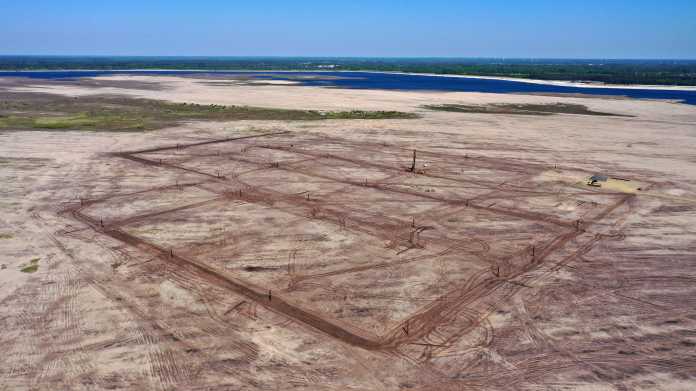Start of construction on the Baltic Sea site near Cottbus/Chóśebuz: The 34 dolphins for the largest floating solar system in Germany have been stuck in the future seabed since Tuesday. Next, almost 1,900 floats and around 51,000 solar modules will be attached to these 15-meter-long steel tubes. They will float as the water level rises and are expected to produce electricity from the second half of 2024. 21 megawatts were originally planned, but thanks to improvements, 29 MW are now being installed.
At 16 hectares, the solar system will be the largest floating photovoltaic system in Germany. The Cottbusser Ostsee is a remaining hole of the opencast coal mine in Lower Lusatia. It has been flooded since 2019; more than 80 percent of the water comes from the Spree, the rest is groundwater. The water supply is adjusted weekly to the respective water level of the Spree. The flooding could be complete by 2030. When fully filled, the Baltic Sea will have 150 million cubic meters of water and an area of 19 square kilometers.
The solar power plant will therefore cover less than one percent of the lake area. For investor LEAG, the “innovative anchoring based on rammed dolphins” is the technical “highlight” of the project. The method, which has been tried and tested at piers, among other things, is being used for the first time for a floating solar power plant.
Less hassle, but higher costs
From a political point of view, the system’s relatively low potential for conflict is the main advantage: because the panels float flat on the water and are installed as far as possible from the shore sections used by tourists, they can hardly be seen from there. They do not take up any other usable floor space and are located off planned shipping routes. A disadvantage is higher costs compared to a solar power plant on land.
“The city of Cottbus/Chóśebuz has decided to develop a CO2-neutral port and city district as a goal to give new impetus to urban development. Floating PV is only the first step that we are now taking together, further projects such as wind turbines and a seawater heat pump will follow,” said the then Mayor Holger Kelch in October.

Aerial view of the Baltic Sea area with the dolphins to which the floating solar power plant will be attached
(Image: LEAGUE)
LEAG is owned equally by Czech Energetický a průmyslový Holding (EPH) and Jersey-registered company PPF Investments. Their website names the Czech Tomas Brzobohaty as the majority owner. EPH is almost entirely owned by his compatriot Daniel Křetínský.
A floating photovoltaic system, half the size, with an output of 15 megawatts is scheduled to go into operation on the Kiessee between Karlsruhe and Heidelberg before the end of this year. In the first full year of operation, it will generate almost 16 gigawatt hours of electricity for the local Philipp gravel plant. Any surplus goes into the power grid. Investors there are the companies Philipp & Co and O&L Europe, the project is being carried out by the Bavarian company O&L Nextentury. Project developer in Cottbus is the local company EP New Energies.
(ds)
